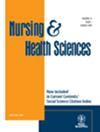种族中心主义与仇外心理水平之间的关系及预测因素:对在土耳其难民集中居住的两个城市工作的护士进行的描述性和相关性研究
IF 2.1
3区 医学
Q2 NURSING
引用次数: 0
摘要
确定护士的种族中心主义和仇外心理水平有助于护士了解自己对这一问题的态度并提供优质护理服务。这项描述性和相关性研究旨在确定在土耳其难民集中居住的两个不同边境地区的医院工作的护士的种族中心主义和仇外心理水平之间的关系。研究对象是在土耳其南部两个城市的两家不同医院工作的 386 名护士。研究使用 "个人信息表"、"种族中心主义量表 "和 "仇外心理量表 "收集数据。结果显示,约有一半的护士不愿意照顾外国病人。种族中心主义量表 "和 "排外主义量表 "的平均得分之间存在着积极的统计学关系(p < 0.05)。回归分析表明,民族中心主义水平可解释 9% 的排外水平。护士的排外程度较高,民族中心主义态度一般。随着护士种族中心主义水平的提高,排外水平也随之提高。建议开展进一步研究,以确定护士仇外心理的不同预测因素。本文章由计算机程序翻译,如有差异,请以英文原文为准。
The relationship between ethnocentrism and xenophobia level and predictors: A descriptive and correlational study of nurses working in two cities where refugees live intensively in Turkey
Determining the ethnocentrism and xenophobia levels of nurses contributes to nurses' awareness regarding their attitudes on the issue and providing quality care. This descriptive and correlational study aimed to determine the relationship between ethnocentrism and xenophobia levels of nurses working in hospitals located in two different border regions where refugees live intensively in Turkey. The study was conducted with 386 nurses who were working in two different hospitals located in two cities in the south of Turkey. Data were collected using the “Personal Information Form,” “Ethnocentrism Scale,” and “Xenophobia Scale.” About half of the nurses did not want to care for foreign patients. There was a positive and statistically significant relationship between mean scores of the Ethnocentrism Scale and the Xenophobia Scale (p < 0.05). The regression analysis indicated that the level of ethnocentrism explains the level of xenophobia by 9%. Nurses had a high level of xenophobia and moderate ethnocentric attitudes. The level of xenophobia increased as the ethnocentrism level of nurses increased. It is recommended to conduct further studies to determine different predictors of xenophobia among nurses.
求助全文
通过发布文献求助,成功后即可免费获取论文全文。
去求助
来源期刊
CiteScore
4.80
自引率
3.70%
发文量
91
审稿时长
6-12 weeks
期刊介绍:
NHS has a multidisciplinary focus and broad scope and a particular focus on the translation of research into clinical practice, inter-disciplinary and multidisciplinary work, primary health care, health promotion, health education, management of communicable and non-communicable diseases, implementation of technological innovations and inclusive multicultural approaches to health services and care.

 求助内容:
求助内容: 应助结果提醒方式:
应助结果提醒方式:


